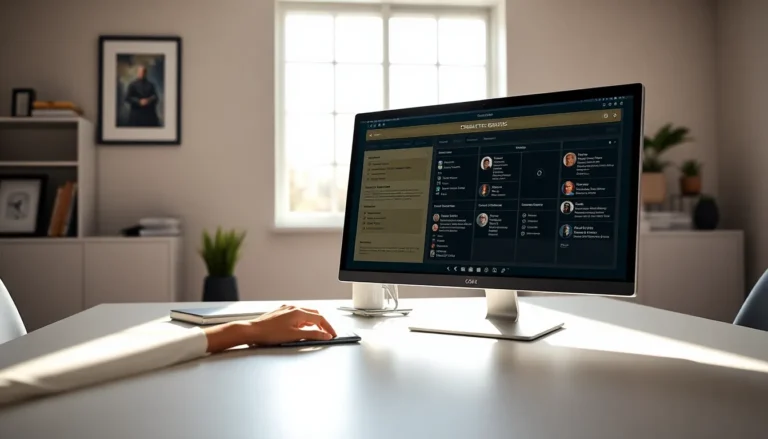Table of Contents
ToggleIn a world where pajamas have become the new business casual, navigating remote work etiquette can feel like walking a tightrope—one foot in comfort and the other in professionalism. With video calls replacing water cooler chats, it’s crucial to master the art of virtual interaction. After all, nobody wants to be that person who forgets to mute their mic while their cat decides to audition for a role in the next big blockbuster.
Remote work might offer the freedom to sip coffee in bed, but it also demands a new set of unwritten rules. From mastering the perfect background to knowing when to turn off the camera during a “boring” meeting, understanding these nuances can elevate one’s professional game. So grab your favorite mug, settle in, and let’s dive into the essential dos and don’ts of remote work etiquette that’ll keep you both comfy and classy.
Understanding Remote Work Etiquette
Remote work etiquette encompasses the behaviors and practices that promote professionalism in a virtual environment. Mastering this etiquette fosters positive interactions among team members despite physical distance.
Definition of Remote Work Etiquette
Remote work etiquette defines the expected standards of conduct and communication while working from home or any remote location. These guidelines include appropriate dress codes, maintaining a respectful workspace, and adhering to communication norms. Clear boundaries between personal and professional spaces contribute to a productive work atmosphere. Understanding these unwritten rules ensures everyone maintains respect in virtual interactions.
Importance of Remote Work Etiquette
Remote work etiquette plays a crucial role in shaping workplace dynamics. It enhances clarity in communications, which helps prevent misunderstandings that can arise in virtual settings. Cohesion among team members improves as individuals respect each other’s time and space. Proper etiquette creates a professional image, reinforcing trustworthiness within the team. Prioritizing these behaviors increases overall productivity and morale, making collaboration smoother and more effective.
Key Principles of Remote Work Etiquette

Remote work etiquette requires adherence to specific guidelines that enhance professional interactions. These principles establish a framework for a productive work environment from home.
Communication Best Practices
Effective communication relies on clarity and respect. Use concise language to convey messages without ambiguity. Be prompt in responding to emails and messages, aiming for a turnaround of 24 hours. During video calls, maintain eye contact with the camera and mute the microphone when not speaking to prevent distractions. Utilize appropriate channels for different types of communication; for example, use instant messaging for quick questions, while emails work best for detailed information. Emphasizing empathy in all interactions fosters positive relationships within the team.
Time Management and Punctuality
Punctuality plays a crucial role in remote work etiquette. Aim to join meetings on time, demonstrating respect for others’ schedules. Prioritize tasks using to-do lists to stay organized and meet deadlines consistently. Break projects into manageable parts to avoid overwhelm, and set specific time blocks for focused work. Establish boundaries between work and personal time, helping to maintain productivity. Create a designated workspace that minimizes distractions and enhances concentration, leading to higher efficiency and better results.
Virtual Meeting Etiquette
Mastering virtual meeting etiquette enhances professionalism. Preparing in advance helps avoid distractions.
Preparation for Meetings
Researching the meeting agenda enables participation. Checking technology, including audio and video, ensures a smooth start. Participants should find a quiet area, free from interruptions, to maintain focus. Setting up a tidy background presents a professional image. Dressing appropriately, even if working remotely, reinforces professionalism. Testing the internet connection prevents delays and maximizes productivity. Knowing participants’ names and roles aids in engagement during discussions.
Conduct During Meetings
Maintaining eye contact fosters connection with colleagues. Silencing notifications minimizes distractions and promotes engagement. Speaking clearly and concisely keeps the conversation on track. Listening actively helps understand others’ viewpoints and encourages collaboration. Avoid multitasking to demonstrate commitment to the meeting’s agenda. Utilizing the chat function thoughtfully allows for questions without interrupting speakers. Timing contributions appropriately demonstrates respect for others’ input and keeps discussions productive.
Setting Boundaries in Remote Work
Establishing boundaries is crucial for maintaining professionalism in a remote work environment. Setting clear limits helps individuals separate work time from personal time.
Work-Life Balance
Achieving work-life balance is essential for productivity. Designating specific hours for work prevents tasks from spilling into personal time. It encourages individuals to communicate their availability to team members, reducing interruptions. Prioritizing breaks is also vital, as short pauses improve focus and energy levels. Others should respect these boundaries, fostering a healthier work environment for everyone involved.
Creating a Dedicated Workspace
Creating a dedicated workspace enhances focus and productivity. Selecting a specific area in the home reduces distractions and signals to others that work is in progress. Ensuring the workspace is ergonomic promotes comfort during long hours. Additionally, personalizing the area with plants or motivational items can boost morale. It’s important to keep the workspace tidy, which reflects professionalism and reduces stress.
Building Relationships Remotely
Building relationships in a remote setting hinges on effective communication and intentional engagement.
Networking in a Virtual Environment
Networking thrives in virtual environments with the right strategies. Establishing connections starts with attending online events and webinars relevant to the industry. Engaging in discussions on social media platforms fosters visibility, while sharing insights and resources can initiate meaningful dialogues. Reaching out directly through targeted messages or emails enhances personal interaction and creates opportunities for collaboration. Joining interest groups or forums also aids in expanding professional networks, allowing individuals to connect with like-minded professionals. Active participation in group discussions builds rapport, making individuals memorable within their networks.
Maintaining Team Cohesion
Maintaining team cohesion requires consistent efforts in communication and collaboration. Regular check-ins through video calls strengthen team bonds and foster transparency. Team-building activities, even when conducted online, encourage positive relationships among members. Running virtual brainstorming sessions promotes inclusivity, allowing everyone to share ideas. Celebrating team milestones and individual accomplishments creates a sense of belonging. Utilizing collaboration tools helps streamline communication, making it easier to share updates and projects. Sharing personal anecdotes during meetings can humanize interactions, reinforcing connections among teammates.
Mastering remote work etiquette is essential for creating a productive and professional environment. By adhering to the guidelines discussed, individuals can enhance their virtual interactions and foster stronger relationships within their teams. Proper communication practices and attention to detail during meetings can significantly improve collaboration and trust.
Establishing boundaries between work and personal life not only boosts productivity but also supports overall well-being. A dedicated workspace and a professional appearance contribute to a positive work atmosphere, making it easier to focus on tasks at hand.
As remote work continues to evolve, embracing these etiquette principles will help individuals navigate challenges and thrive in a virtual setting.




